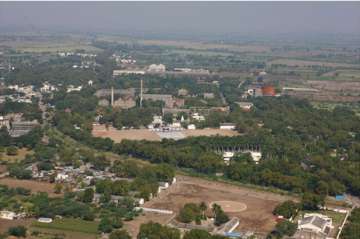It's easy to not take a note of Walchandnagar village in western Maharashtra when yours eyes can please themselves to the Mumbai boulevard skyline. With the looks of just another depraved village of India's rural landscape, this small village is sure to take you by surprise with its close link to India's ambitious space programme.
The 'catch' is the name itself. Its named after legendary Indian entrepreneur Walchand Hirachand who laid foundation to some of the biggest nation building projects.
The 110-year-old Walchand Industries Ltd (WIL), located here, has a turnover of Rs 400 crore with around 1,400 employees in Walchandnagar's population of around 15,000, and is playing a pivotal role in India's space programmes.
WIL was originally a heavy engineering giant making hi-tech engineering products, including sugar plants, co-generation plants, cement plants and other basic industries, in tune with the vision of Walchand Hirachand.
After Independence, it gradually reworked its DNA to diversify into defence, nuclear and aerospace to match the country's needs.
Walchand Hirachand had set up Hindustan Shipyard Ltd (Vishakhapatnam) and Hindustan Aeronautics Ltd (Bengaluru). They were later involved in manufacturing and supplying sensitive components to nuclear power plants in the country.
Since 1973, the company started delving into rocket science, literally. WIL Managing Director-cum-CEO G.K. Pillai told IANS and added, it started with the SLV-3 project and since 2003 the company was working on GSLV Mk II projects.
"It's a matter of pride for the company as it made critical components for the proposed Chandrayaan 2 rocket 'Bahubali', which will take an orbiter, lander and rover to explore the Moon's South Pole," Pillai said. (The launch was scheduled for July 15, but has been postponed due to a technical snag).
In an active, but low-profile collaboration with the Indian Space Research Organisation (ISRO) since 1973, WIL provided several critical equipments to India's maiden mission to moon -- the Chandrayaan 1 explorer -- that was launched on October 22, 2008.
Pillai said WIL would play a crucial role in Gaganyaan, India's first manned space mission in 2022, but declined to elaborate.
Around 1979, WIL started manufacturing and supplying motor cases for ISRO's Satellite Launch Vehicle (SLV)-3 project. But the experimental flight in August 1979 failed. It was followed by a successful launch in July 1980, marking India's indigenous foray into space.
Prior to that, India had launched its first satellite Aryabhatta in April 1975 and then Bhaskara Sega-1 in June 1979, both from the Kapustin Yar Missile and Space Complex, in the erstwhile USSR.
As the country's space programme blossomed, WIL also flourished and manufactured important components for various projects, like SLV-3, ASLV to PSLV and GSLV Mk II and GSLV Mk III.
"WIL's equipment have been successfully used in launching Rohini, Sross (Stretched Rohini Satellite Series), IRS (India's remote sensing programme), G-Sat and other Indian satellites," Pillai said.
Till date, the company has contributed 141 strap-on boosters for PSLV/GSLV Mk II, 151 core boosters for PSLV/GSLV Mk II, 16 core boosters for GSLV Mk III, besides other hardware, like nozzles, tankages and end rings.
The company is set to deliver hardware for a dozen PSLV flights per year and four GSLV Mk III flights per year from its facility in Walchandnagar to ISRO.
The facility boasts of technical know-how and skilled manpower to handle aerospace grade materials, like 15CDV6, high-strength maraging steel, titanium and its alloys, and aluminium alloys.
It has also established critical process parameters for wide-ranging manufacturing processes for metal forming, metal joining, heat-treatment, fabrication, precision machining and pressure testing for large-sized jobs having complex geometry.
Walchand Hirachand had set up India's first 'desi' automobile manufacturing company, which churned out the quaint Premier Padmini sedans from 1949, a few of which are still visible on Mumbai roads, beating the Birla Group's Hindustan Motors Ltd.
Also Read | ISRO calls off Chandrayaan-2 launch indefinitely due to technical snag, revised date to be announced later
